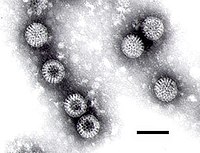
Emerging Orbiviral Infections in Animals in the Climate Change Scenario: Evidence of Bluetongue Virus Antibodies and Antigens in Small Ruminants of Andaman and Nicobar Islands, India
Sign Up to like & getrecommendations! Published in 2019 at "National Academy Science Letters"
DOI: 10.1007/s40009-019-0787-6
Abstract: A study was conducted in 2016 to observe the seroprevalence and antigenic prevalence of bluetongue virus (BTV) in goats of Andaman and Nicobar Islands, India. Indirect ELISA and sandwich ELISA were employed to study the… read more here.
Keywords: bluetongue virus; islands india; study; nicobar islands ... See more keywords

Molecular typing of Bluetongue virus using the nCounter® analysis system platform.
Sign Up to like & getrecommendations! Published in 2019 at "Journal of virological methods"
DOI: 10.1016/j.jviromet.2019.04.002
Abstract: Bluetongue virus (BTV) is a segmented double-stranded RNA virus, existing in multiple serotypes, belonging to the genus Orbivirus of the family Reoviridae. BTV causes Bluetongue (BT), a major OIE-listed disease of ruminants. Identification of BTV… read more here.
Keywords: analysis system; btv; bluetongue virus; virus ... See more keywords

Development of real-time RT-qPCR assays for the typing of two novel bluetongue virus genotypes derived from sheeppox vaccine.
Sign Up to like & getrecommendations! Published in 2021 at "Journal of virological methods"
DOI: 10.1016/j.jviromet.2021.114288
Abstract: Previously, we reported the detection of two novel bluetongue virus (BTV) strains (SPvvvv/02 and SPvvvv/03), possibly representing new BTV genotypes, in a batch of sheeppox vaccine. We developed type-specific RT-qPCR assays (targeting genome segment 2)… read more here.
Keywords: bluetongue virus; novel bluetongue; btv; qpcr assays ... See more keywords

Environmental heterogeneity and variations in the velocity of bluetongue virus spread in six European epidemics.
Sign Up to like & getrecommendations! Published in 2018 at "Preventive veterinary medicine"
DOI: 10.1016/j.prevetmed.2017.11.005
Abstract: Several epidemics caused by different bluetongue virus (BTV) serotypes occurred in European ruminants since the early 2000. Studies on the spatial distribution of these vector-borne infections and the main vector species highlighted contrasted eco-climatic regions… read more here.
Keywords: btv 2014; velocity; spread; btv ... See more keywords

Large-scale seroprevalence and risk factors associated with Bluetongue virus in Iran.
Sign Up to like & getrecommendations! Published in 2020 at "Preventive veterinary medicine"
DOI: 10.1016/j.prevetmed.2020.104994
Abstract: Bluetongue virus (BTV) remains as an economically major concern in the world. Seroprevalence and potential risk factors of BTV were assessed in a cross-sectional study at both the herd and animal levels in Iran. A… read more here.
Keywords: risk; seroprevalence; infection; btv ... See more keywords

A review of potential bluetongue virus vaccine strategies.
Sign Up to like & getrecommendations! Published in 2017 at "Veterinary microbiology"
DOI: 10.1016/j.vetmic.2017.03.015
Abstract: Bluetongue (BT) is an economically important, non-zoonotic arboviral disease of certain wild and domestic species of cloven-hooved ungulates. Bluetongue virus (BTV) is the causative agent and the occurrence of BTV infection is distinctly seasonal in… read more here.
Keywords: bluetongue virus; vaccine strategies; review potential;

Evaluation of the immune response afforded by a subunit vaccine candidate against bluetongue virus in mice and sheep.
Sign Up to like & getrecommendations! Published in 2018 at "Veterinary microbiology"
DOI: 10.1016/j.vetmic.2018.04.007
Abstract: Bluetongue virus (BTV), a vector-borne pathogen, is the causative agent of bluetongue disease in ruminants. In view of the recent emergence of BTV in regions previously known to be free from the disease and/or specific… read more here.
Keywords: bluetongue; response; vaccine candidate; subunit vaccine ... See more keywords

Hidden symmetry of the anomalous bluetongue virus capsid and its role in the infection process.
Sign Up to like & getrecommendations! Published in 2019 at "Soft matter"
DOI: 10.1039/c9sm01335k
Abstract: Clear understanding of the principles that control the arrangement of proteins and their self-assembly into viral shells is very important for the development of antiviral strategies. Here we consider the structural peculiarities and hidden symmetry… read more here.
Keywords: hidden symmetry; anomalous bluetongue; symmetry; bluetongue virus ... See more keywords

Development of Competitive Enzyme-Linked Immunosorbent Assays for Antibody Detection Based on Bluetongue Virus Monoclonal Antibodies.
Sign Up to like & getrecommendations! Published in 2018 at "Viral immunology"
DOI: 10.1089/vim.2017.0106
Abstract: Bluetongue is a ruminant infectious disease that is characterized by hyperpyrexia, leukocyte decrease and mucosal ulcerative inflammation changes. In this study, three segments of Bluetongue virus (BTV)-8 VP2 protein (BTV-8A, 8B, and 8C) were cloned… read more here.
Keywords: competitive enzyme; antibody; linked immunosorbent; immunosorbent assays ... See more keywords

Rapid and Efficient Detection by PCR of Culicoides insignis (Diptera: Ceratopogonidae), the Main Vector of Bluetongue Virus (BTV) in the Neotropical Region
Sign Up to like & getrecommendations! Published in 2022 at "Journal of Medical Entomology"
DOI: 10.1093/jme/tjac065
Abstract: Abstract Bluetongue virus (BTV) causes a viral, non-contagious disease that mainly affects sheep, cattle, and wild and farmed ruminants causing damage to these animals and significant economic losses. Culicoides insignis Lutz, the major BTV vector… read more here.
Keywords: bluetongue virus; virus btv; vector; culicoides insignis ... See more keywords

Bluetongue virus spread in Europe is a consequence of climatic, landscape and vertebrate host factors as revealed by phylogeographic inference
Sign Up to like & getrecommendations! Published in 2017 at "Proceedings of the Royal Society B: Biological Sciences"
DOI: 10.1098/rspb.2017.0919
Abstract: Spatio-temporal patterns of the spread of infectious diseases are commonly driven by environmental and ecological factors. This is particularly true for vector-borne diseases because vector populations can be strongly affected by host distribution as well… read more here.
Keywords: virus spread; climatic landscape; landscape; host ... See more keywords